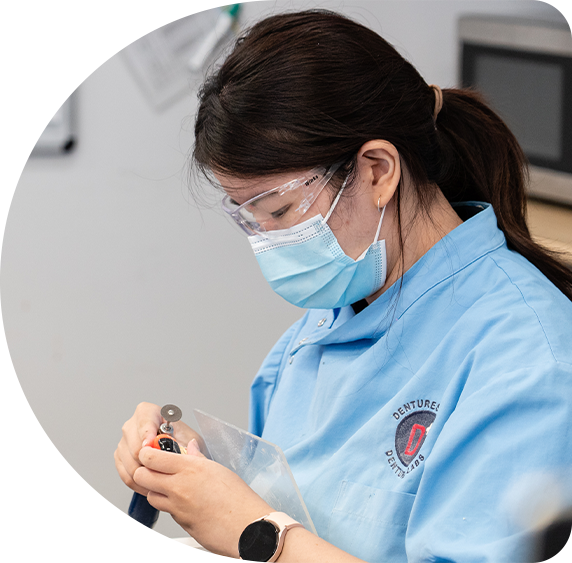We're here to help
We offer a range of dental implant solutions in Perth — whether you’re missing one tooth or several.
If you’re unsure where to start, our expert team is here to guide you every step of the way.
Scroll down for our step-by-step guide on implant options and what to expect.
Life changing smiles
Feel the confidence of smiling with a beautiful, full set of teeth.
With easy payment plans available, including early access to your super, we’re making it more accessible than ever.


Not sure which dental
implant option is right for you?
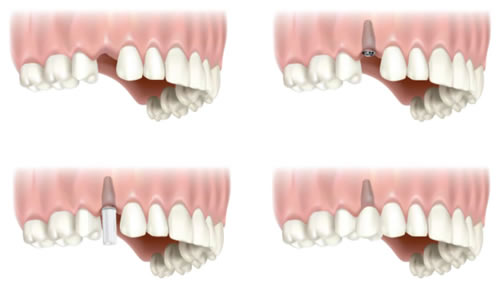
In the past, the main options for replacing a single missing tooth were either a removable denture or a fixed bridge attached to the teeth on either side of the gap. While bridges can be effective, they come with a significant downside. To place a bridge, the healthy teeth next to the missing tooth must be ground down to support the structure, which can weaken them over time.
Today, dental implants offer a more advanced and conservative alternative. A single implant allows you to replace a missing tooth without causing any damage to the surrounding teeth. It provides a permanent solution that looks, feels, and functions just like a natural tooth.
The implant itself is a small titanium post designed to replicate the root of a natural tooth. Once placed into the jawbone where the tooth is missing, it gradually bonds with the bone through a process known as osseointegration. This creates a stable foundation for the replacement tooth.
Once the implant has successfully integrated with the bone, a mould is taken to accurately capture the shape of your mouth. This is used to craft a custom-made ceramic crown that fits perfectly in the space. Within one to two weeks, the final crown is attached to the implant.
The result is a strong, natural-looking tooth replacement that can last for many years with proper care. It restores both the appearance and function of your smile without compromising the health of your other teeth.
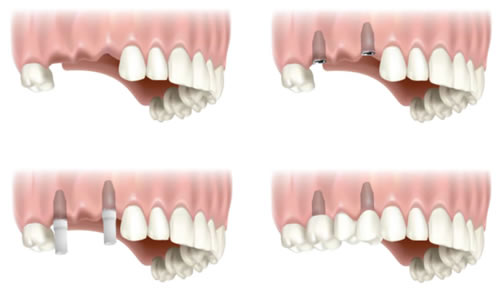
When two or more teeth are missing, there are several ways to restore both appearance and function in the mouth. One common solution is a removable partial denture, which can be made from plastic or metal. Another option is a fixed bridge, which is designed to replace the missing teeth by resting on the remaining natural teeth.
However, both of these traditional approaches have some limitations. Dentures and fixed bridges do not prevent the bone beneath the missing teeth from shrinking over time. Without the natural stimulation provided by tooth roots, the jawbone in those areas begins to deteriorate. As a result, dentures and bridges often need to be remade after several years due to changes in the shape of the gums and jaw. In addition, fixed bridges require the healthy teeth on either side of the gap to be ground down so they can support the restoration, which can compromise the long-term health of those teeth.
A more modern and effective solution is to place a bridge that is supported by dental implants. This type of bridge does not rely on any remaining natural teeth for support, meaning no healthy teeth are altered or damaged. Dental implants also help prevent bone loss by stimulating the jawbone, much like natural tooth roots would.
The number of implants required to support the bridge depends on the number of missing teeth and the quality of your bone. Your dentist will evaluate your specific situation and determine how many implants are needed to provide a stable and lasting result.
After the implants have been successfully placed and have integrated with the bone, your dentist will take a mould of your mouth. This mould is used to fabricate a custom-made ceramic bridge that matches the look and function of your natural teeth. The bridge is then securely attached to the implants using small gold screws or a permanent dental adhesive, effectively replacing the missing teeth and restoring full function.
If any issues ever arise with the bridge, such as a chip or crack, it can be removed by your dentist and sent to a dental technician for professional repair. This ensures that your implant-supported bridge remains a durable and reliable solution for many years to come.
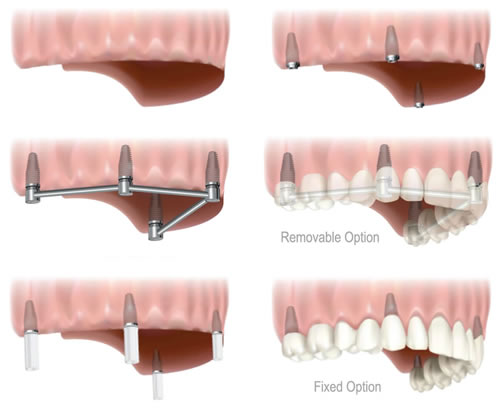
When all of the teeth are missing in either the upper or lower jaw, there are three main treatment options available to restore your smile and function.
The first option is a standard removable denture. This type of denture rests directly on the gums and is held in place by natural suction and, in some cases, denture adhesive. While it can be a cost-effective solution, it may feel loose or unstable, especially over time as the jawbone shrinks and the fit changes.
The second option is an implant-retained denture. This is still removable, but it is far more stable than a traditional denture. In this approach, several dental implants are placed in the jaw, and small attachments are fixed to the top of each implant. The denture is then designed with matching clips or housings that connect securely to these attachments. When inserted, the denture “clips” into place and stays firmly secured during eating and speaking. Despite being removable, it offers a much higher level of comfort and confidence. To remove it, you simply unclip the denture using your fingers.
One major advantage of this solution, particularly for upper dentures, is that the palate section of the denture can often be removed. This restores the natural feel of the mouth and allows you to enjoy the full sensation and taste of food, which is often reduced with a traditional upper denture.
The third option is a fixed implant-supported bridge. This involves attaching a full arch of ceramic teeth to multiple implants using specialised screws. The result is a non-removable set of teeth that closely mimic the feel and function of natural teeth. Typically, four or more implants are required to support the bridge, and only a dentist can remove it if any maintenance or adjustments are needed. This solution provides excellent stability and aesthetics, and allows you to eat, speak, and smile without worrying about movement or slippage.
As with all dental implant treatments, maintaining excellent oral hygiene is essential to ensure long-term success. Regular dental check-ups and professional cleans will help keep the implants and surrounding gum tissue healthy for many years to come.
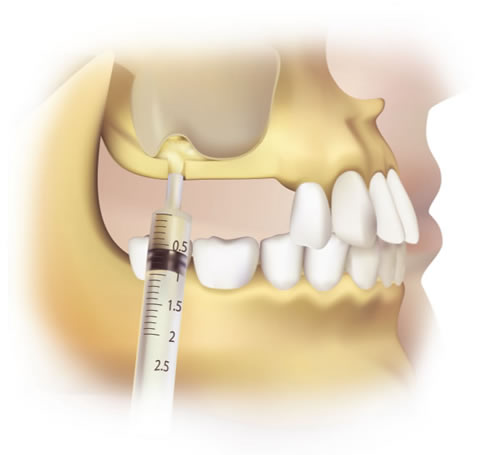
In some cases, when teeth have been missing for an extended period of time, the jawbone may shrink to the point where there is not enough bone to support dental implants using the standard approach.
To allow for successful implant placement in these situations, a procedure known as a bone graft or sinus lift may be required. This involves adding bone material to the area where the implants are intended to be placed. The added bone increases the thickness and volume of the jawbone, creating a solid foundation for the implants.
In the upper jaw, this procedure is typically referred to as a sinus lift or sinus graft. In the lower jaw, it is generally called a bone graft. Both procedures serve the same purpose, which is to rebuild the bone and make implant treatment possible.
As dental implants have become increasingly popular, sinus lifts and bone grafts are now common procedures performed in many dental and surgical clinics. During a sinus lift, your surgeon gently lifts the thin membrane that lines the inside of your sinus cavity away from the floor of the sinus. Bone material is then placed into this space, increasing the height of the upper jaw in preparation for implants.
Following the graft, a healing period of around six months is typically required. During this time, the grafted bone will integrate with your body, develop its own blood supply, and transform into healthy, living bone. Once the healing is complete and the bone has matured, dental implants can be placed safely and securely, provided no complications have occurred.
The bone used for the graft may come from your own body or may be sourced from a certified donor supply, often referred to as a bone bank. Your oral surgeon will explain these options to you during your consultation and help you decide which approach is most appropriate for your individual case.
Permanent implant surgery is considered one of the safest and most reliable procedures in modern dentistry when carried out by a qualified and experienced dentist. According to the American Academy of Implant Dentistry, it has a strong track record of success. The Australian Dental Association also notes that with proper care and maintenance, dental implants can last for many years. However, as with any dental appliance, occasional repairs or adjustments may still be required over time.
To determine if you are a suitable candidate for dental implants, your dentist will need to assess the quality and quantity of your jawbone. This is typically done using X-rays and, in some cases, a CT scan to get a detailed view of the bone structure. Certain medical conditions, such as uncontrolled diabetes, HIV, or leukemia, can interfere with the healing process and the ability of the bone to bond with the implant. These conditions require thorough evaluation and careful planning. However, in most cases, individuals who are in generally good health are considered suitable for dental implant treatment. Your dentist will discuss all relevant health factors with you during your consultation to ensure the best possible outcome.
The cost of dental implant treatment can vary depending on your individual needs. An accurate quote will be provided by your dentist or dental specialist after a full assessment. This quotation will outline all the expected costs involved in your treatment.
The final cost depends on several factors, including the specific components required, the complexity of the procedure, and any additional services such as hospitalisation, medication, or specialist involvement. While implant treatment may initially seem more expensive than options like bridges or dentures, the long-term value is often greater. Unlike traditional alternatives that may need to be replaced every few years, dental implants can last for decades or even a lifetime when properly maintained.
To make treatment more accessible, we offer a variety of flexible payment plans. These include options such as early access to your Superannuation, allowing you to begin treatment without unnecessary financial stress.
Getting dental implants may involve some level of discomfort, but it is generally well controlled with local anaesthesia and proper aftercare. During the procedure, most patients report feeling pressure rather than pain, as the area is thoroughly numbed before treatment begins.
After the surgery, it is normal to experience mild soreness, swelling, or bruising around the implant site for a few days. These symptoms are similar to what you might feel after a tooth extraction and are part of the body’s natural healing process.
Pain is usually mild to moderate and can be effectively managed with over-the-counter pain relief medications. In some cases, your dentist or oral surgeon may prescribe additional medication to help reduce inflammation or relieve discomfort, especially if the procedure was more complex.
Most people find the recovery period quite manageable, with symptoms gradually improving over the course of one to two weeks. If you notice that pain worsens or does not improve as expected, it is important to contact your dentist. Persistent discomfort could indicate an issue such as infection or delayed healing, and early intervention is key to resolving any complications.
Dental implants can be placed in a wide range of age groups. The youngest patients typically receive implants in their late teens, once jaw growth has stabilised, while the oldest recipients can be well into their 90s. Age itself is not usually a limiting factor. Instead, overall health, bone quality, and oral hygiene are more important considerations.
When teeth are missing for an extended period, the jawbone in that area begins to shrink due to lack of stimulation. This bone loss is especially common in people who wear dentures, as the ridge that helps support the denture gradually diminishes over time. As the bone recedes, the fit of the denture can become loose and uncomfortable.
Dental implants help restore normal function by applying pressure to the bone, which prevents further deterioration. The earlier you decide to have implants placed, the better the chances of preserving existing bone and achieving an ideal aesthetic outcome. Early intervention often means a simpler, more predictable treatment process and better long-term results.
Implant treatment is a highly technical and specialised area of dentistry. Not all dentists perform implant procedures, as it requires specific training, experience, and equipment. Because of this, your general dentist may refer you to a specialist for part or all of your implant treatment.
The surgical placement of the dental implant is typically carried out by a Maxillofacial and Oral Surgeon, a Periodontist, or a trained Dentist with experience in implant surgery. Once the implant is in place, the design and fitting of the artificial tooth or teeth are completed by a Dentist or Prosthodontist. This is done in collaboration with a skilled Dental Technician who fabricates the final restorations.
If you are considering dental implants, speak with your dentist to learn more about your options and to find out which approach is most suitable for your needs.
Caring for dental implants is very similar to caring for natural teeth. Good oral hygiene is essential for long-term success.
This includes brushing twice daily with a soft-bristled toothbrush, flossing or using interdental brushes to clean around the implant, and visiting your dentist regularly for check-ups and professional cleans.
Although implants do not decay like natural teeth, the surrounding gums and bone can still be affected by plaque build-up, which may lead to peri-implantitis if not properly managed.
Your dentist or hygienist may recommend specific cleaning techniques or tools to help you maintain optimal implant health.

Easy finance to help you
access dental care

Smile Now Pay Later
There’s no risk. If you don’t get approved, it won’t impact your credit score.
We partner with Pretty Penny Finance* to provide this service.
* Dentistry Plus Pty Ltd ABN 32 605 704 523 – Credit Representative number 486980 is an authorised representative of Pretty Penny Holdings Pty Ltd ABN 69 607 391 168 – Australian Credit Licence 481695

Health Layby Wallet
An alternative to extras health cover, where you don’t lose your money if nothing happens.
ZIP pay
The easy way to pay for non-major dental procedures.
The button below will take you to Zip Money website.
Early Super Release
If eligible, gain early access to your superannuation to fund your treatment.
We partner with SuperCare to provide this service.

16 years of smiles
Starting from humble beginnings in 2008, Dentistry Plus’ customer base has rapidly grown through excellent service and a World class approach to dentistry.
Because of this, you can find Dentistry Plus in 7 locations (with more to come) across Perth.
Quality in every service
Today, Dentistry Plus continues to grow with a strong focus on quality of service.
Every dental clinic is equipped with the latest technology and all our dentists are carefully selected to ensure that every procedure, from a simple scale and clean to a full dental reconstruction, is performed to the highest possible standard.
